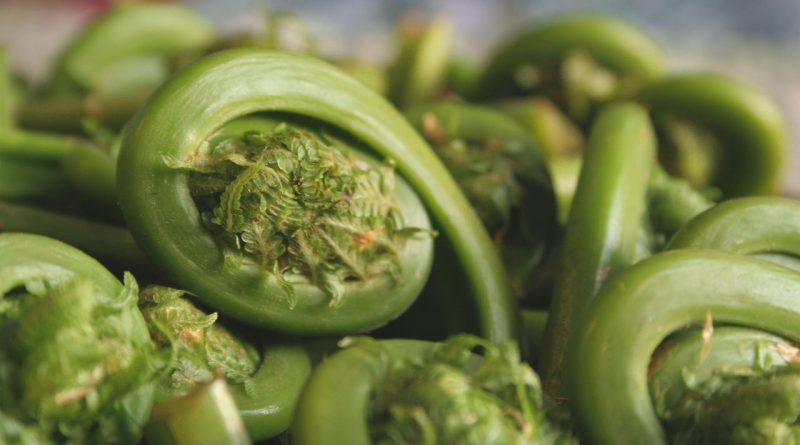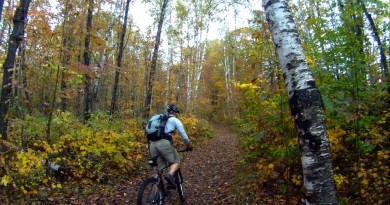Eat Wild: Forest Foraging Tips
By Ari Rockland-Miller. Photos by Jenne Antonino DiMare
May is the month when you can find an entire meal in the forest. Expert forager Ari Rockland-Miller shares his tips.
I arrive at my early fiddlehead spot in mid-April for a quick scout, but it’s still too soon. There is no sign  yet of the towering ostrich ferns that soar from the soil with the urgency of springtime. I know I’m in the right spot, though—a forager does not forget, and the skeletons of last year’s fertile fronds serve as flags. I kneel down low and carefully inspect the base of the plants, checking the pulse of the forest. Sure enough, the brilliant green of a tight, unfurled fiddlehead is just barely poking up from the soil. It’s too soon to harvest, but I know the season is upon us.
yet of the towering ostrich ferns that soar from the soil with the urgency of springtime. I know I’m in the right spot, though—a forager does not forget, and the skeletons of last year’s fertile fronds serve as flags. I kneel down low and carefully inspect the base of the plants, checking the pulse of the forest. Sure enough, the brilliant green of a tight, unfurled fiddlehead is just barely poking up from the soil. It’s too soon to harvest, but I know the season is upon us.
Spring is the season for the first flush of wild edibles, from pungent and vitamin–rich greens to bitter, medicinal polypore mushrooms. Everything is as fresh as it is fleeting. Bringing home the bounty requires impeccable timing, knowledge of place, and ecological intuition.
A FOREST BOUNTY
Fiddleheads, the spiraling new fronds of the ostrich fern (Matteuccia struthiopteris), are a whimsical late-April to early-May showstopper and an invitation to the spring feast. The ostrich fern is a stately and widely distributed native plant with a timeless beauty and refined, earthy avor that hints of asparagus.
If you’ve lived in Vermont for long, you’ve surely tasted fiddleheads, and perhaps you’ve even found them along forested riverbanks or in a shaded corner of your backyard. The ostrich fern is not exceptionally rare, but to catch its fiddleheads at the fleeting harvest stage— with tight, unfurled fronds—takes practice. The best time to find a patch of ostrich ferns is in summer, when their towering stature makes them hard to miss. By the time the fronds have opened up enough to make the ostrich fern easily visible, it is too late to harvest, but you can return with precise timing the following spring to enjoy the first fiddleheads.
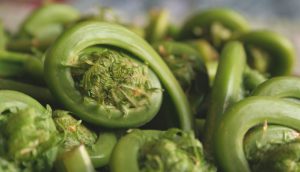 Don’t let the fiddlehead’s charisma fool you—there are some poisonous ferns in Vermont. These include the potentially carcinogenic bracken fern with superficially similar, spiral-shaped fiddleheads. Ostrich fern fiddleheads have a pronounced U-shaped fissure on the inside of the smooth, green stem. The unfurling fiddleheads have flecks of brown, papery chafe that easily fall off when soaked in water. The fiddleheads are the new growth of the vegetative, sterile frond; when harvesting, last year’s fertile fronds appear intermittently as distinctive brown tufts on a stem that also features the signature U-shaped groove.
Don’t let the fiddlehead’s charisma fool you—there are some poisonous ferns in Vermont. These include the potentially carcinogenic bracken fern with superficially similar, spiral-shaped fiddleheads. Ostrich fern fiddleheads have a pronounced U-shaped fissure on the inside of the smooth, green stem. The unfurling fiddleheads have flecks of brown, papery chafe that easily fall off when soaked in water. The fiddleheads are the new growth of the vegetative, sterile frond; when harvesting, last year’s fertile fronds appear intermittently as distinctive brown tufts on a stem that also features the signature U-shaped groove.
Ramps, or wild leeks (Allium tricoccum) are an enchanting spring ephemeral that make a strong showing in deciduous woodlands around early May, soaking up sunlight before the canopy fills in. I have seen acres of ramps that make the spring forest pulse electric with brilliant greens, but even such established patches can be very slow to regenerate if over-picked. Selective harvest of greens, leaving the plump white bulbs in the ground, is considered the more sustainable practice.
If you have a well-functioning nose, ramps are easy to identify–a ripped leaf or bruised bulb releases an overpowering smell layered with garlic and wild funk. Just take care to avoid the deadly ornamental, lily of the valley, known for its fragrant white flowers. Lily of the valley does not smell like a wild leek, but it does have similar foliage and growth habit.
MORELS AND MORE
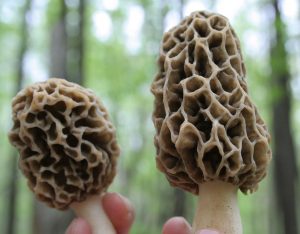
The mycelium, too, is eager to join the festivities, celebrating spring rains with the year’s first flush of fleshy mushrooms.
Dryad’s saddle, or pheasant-back (Polyporus squamosus), is the easiest to find, as well as the safest to identify. It’s not a standout edible, but at its best it can be a refreshing invitation back into wild mushroom season and a satisfying basket-filler.
Dryad’s saddle has white to yellowish pores, rather than gills, below the tan-brown patterned or scaly cap. It grows in a shelf-like habit out of downed logs or older standing hardwoods—often silver maple, boxwood, elm or cottonwood. Perhaps the most distinctive feature is the smell of the fresh pores; highly reminiscent of watermelon rind with a hint of cucumber.
Pored mushrooms like Dryad’s saddle, with spongy underside composed of spore-bearing tubes, are not guaranteed to be edible but tend to be safer than gilled mushrooms. Dryad’s saddle is in a group of pored fungi called the polypores, decomposers that grow shelf-like off wood rather than out of the soil.
Polypores are good species for newer hunters, but it goes without saying that you should have an expert confirm any wild mushroom species you find for the first time, and should never eat any wild mushroom unless you are 100 percent confident (one mistake, however mundane or minor, can be fatal).
Keep in mind that, as a general rule, all wild mushrooms should be cooked for safety and nutrition reasons. Even the divine morel (Morchella sp.) can be toxic consumed raw.
Morels, fruiting alone or gregariously throughout Vermont for a two to three week window in early to mid-May, are the be-all and end-all of spring mushrooms. Varieties include yellow, black and half-free morels. Any are divine wild edibles that speak strongly of terroir and season, evoking singular passion and competition. Morels fruit broadly throughout the Northeast, but nowhere near in the quantities seen in the Midwest or the burns out West. Morels are not just unbelievably delicious–they can be devastatingly difficult to find. I have spent hundreds of hours in fruitless pursuit of them before honing in on a technique and finding proper counsel. They can be found in nearly every corner of the state, but it takes epic patience to find the most productive hotspots.
Morel hunting in Vermont, it turns out, ranges from mediocre (typical throughout the region) to absurdly good, both in terms of quantity and quality. Vermont has some well kept secrets when it comes to morels—it is possible to find several thousand pristine morels in a short season in parts of the state with optimal conditions.
Spend enough time observing patterns and watching aspect, soil, topography, and trees, and the morels begin to make (a bit) more sense. Look in the vicinity of old ash trees, dead elm trees, dead apple trees, and transitions and changes in the landscape. You’ll do better avoiding clay soils, though morels do occasionally fruit in clay. Morels remain thoroughly wild and impossible to quite pin down, so each spring is a new adventure.
Morels have a signature honey-comb appearance, but still have poisonous lookalikes in the genera Gyromitra and Verpa. The “beefsteak,” Gyromitra esculenta, is a particularly common and dangerous false morel, containing a potentially deadly chemical present in rocket fuel!
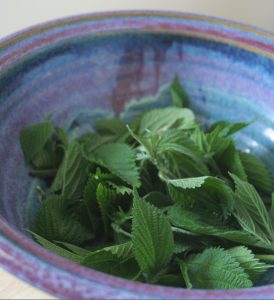
Make sure your morels, when sliced in half vertically, have one contiguous hollow cavity from tip to tail with a crisp appearance and no wrinkles, convolutions, blobs, or cotton-like substance. Again, never eat any wild mushroom unless you have checked with an expert and are 100 percent positive of the identification.
Since morels like disturbance in the landscape, be mindful of potential soil contaminants such as lead, arsenic, or chemical herbicides or pesticides. Likewise, be aware of potential contamination when harvesting any of the weedier greens above, which may thrive along sidewalks or roadways, but should be picked from an unsprayed eld or from a forest’s edge.
BACKYARD TREASURES
Some spring foraged flavors are so accessible they are likely right in your backyard, including the common violet (Viola sororia), dandelion (Taraxacum o cinale) and wood sorrel (Oxalis sp.), which can be consumed raw, and make for colorful salads. The plantain (Plantago major), if harvested young before its leaves become large and tough, is an excellent leafy green.
A few good edibles are so aggressive that eating them could be a form of invasive species control. The sour shoots of infamous Japanese knotweed (Fallopia japonica) are likened to a more savory version of rhubarb, and the leaves of the weedy sheep sorrel (Rumex) have a refreshing, tangy flavor.
Stinging nettles (Ursa diotica) are versatile enough to be used in baked goods, savory dishes, and make an abundant and mineral-rich spinach substitute and cleansing tea. Nettles can even help alleviate symptoms of seasonal allergies. Just be sure to wear long pants and gloves when harvesting, and cook them well to denature their nasty sting. Stinging nettles colonize fields and sun-splashed forest edges, while their native cousin, the wood-nettle (Laportea canadensis), favors stream floodplains and riparian forests in spring. Both come equipped with a stem-full of hairy stingers.
In Vermont we are lucky to have the soils, forests, and ecological diversity to harbor some of the nest wild plants and mushrooms. Spring is an exciting time to pay attention to wild edibles, even if one is not eating them. The successful hunter must approach the harvest with humility, prudence, and respect for the ecosystem. The forager must know his or her own limits as well as the limits of the Earth.
Brattleboro’s Ari Rockland-Miller is a writer, instructor and lecturer on wild and cultivated mushrooms and edible plants and hosts guided walks. He is co-founder of the popular blog The Mushroom Forager, and is author of a forthcoming book on how to safely and fruitfully forage for the most coveted wild mushrooms in North America. For more on foraging or to sign up for guided forays or workshops visit themushroomforager.com.

